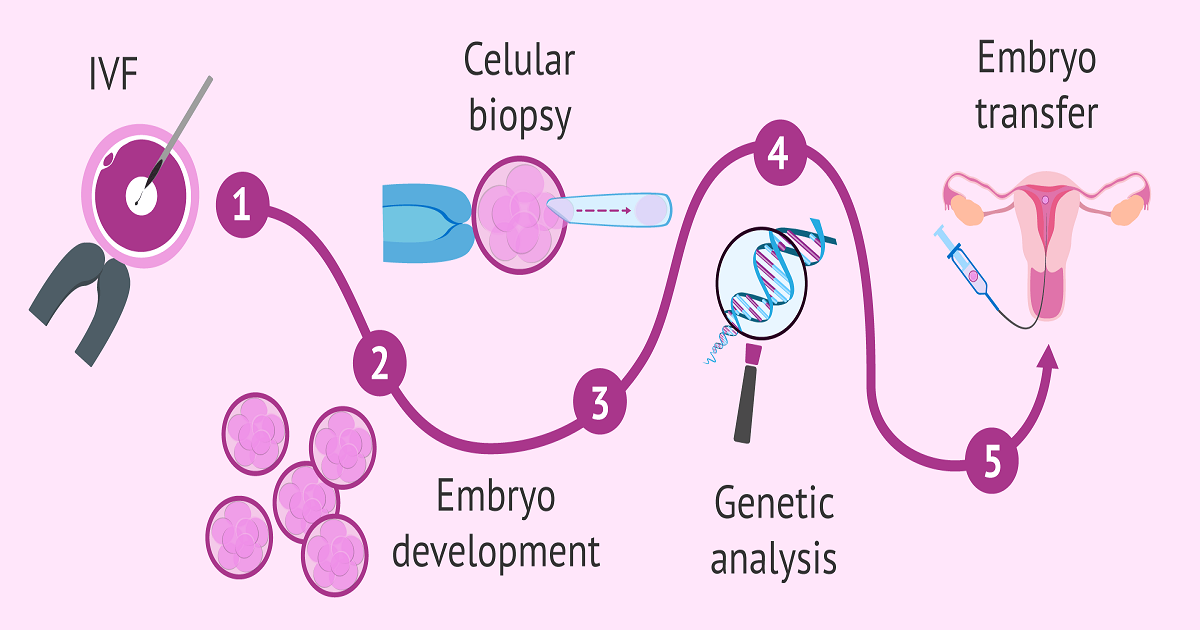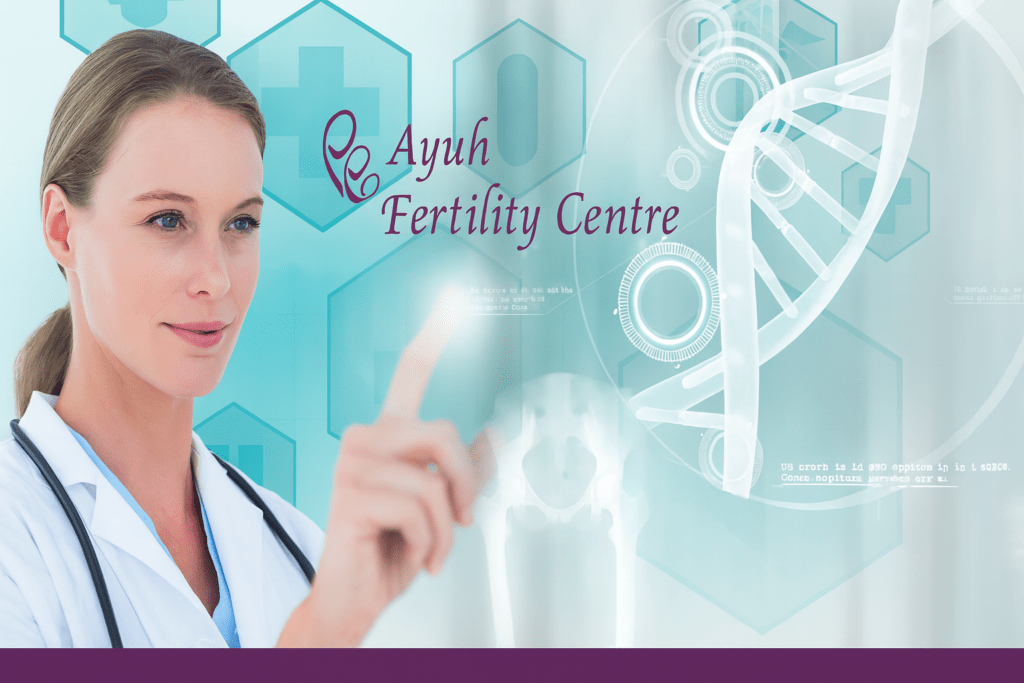Becoming a mother is a dream that many women carry close to their heart. But sometimes, especially after the age of 35, that dream can feel like it’s slipping away. Failed IVF attempts, repeated miscarriages, and endless waiting can leave couples feeling broken and hopeless.
But here’s the good news—science has given us a way to fight back. It’s called Genetic Testing (PGT-A), and it’s helping women over 35 achieve pregnancy faster and with less heartbreak. At Ayuh Fertility Centre, Ahmedabad, we’ve seen this technology turn tears of despair into tears of joy.
What is Genetic Testing (PGT-A), in Simple Words?
Think of embryos as tiny blueprints of a baby. For life to grow, that blueprint has to be correct. Normally, every embryo has 46 chromosomes—half from the mother and half from the father. But as women age, mistakes in these chromosomes become more common.
These “mistakes” can cause:
- IVF failure (when the embryo doesn’t implant)
- Miscarriage (when the pregnancy doesn’t continue)
- Genetic conditions like Down syndrome
Genetic Testing (PGT-A) is like a quality check for embryos. After IVF, before doctors transfer an embryo into the uterus, they take a tiny sample of cells from it and test for chromosomal errors. This way, only the healthiest embryo is chosen for transfer.
It’s like choosing the strongest seed before planting it in the soil.

Why Women Over 35 Need Genetic Testing More
After 35, fertility changes quickly.
- At 30, about 1 in 4 eggs may have problems.
- At 35, nearly 1 in 2 eggs may carry abnormalities.
- By 40, more than 7 in 10 eggs could be affected.
That’s why IVF doesn’t always work for older women. It’s not always the uterus or the clinic—it’s often the quality of the eggs and embryos.
With Genetic Testing, we can separate healthy embryos from unhealthy ones. That simple step saves women from repeated failed cycles and months of pain. At Ayuh Fertility Centre, we’ve seen women over 35 conceive successfully in just one cycle after using PGT-A.
How Does Genetic Testing (PGT-A) Work in IVF?
- Stimulation: Hormone medicines help the ovaries produce multiple eggs.
- Egg Retrieval: Doctors collect the mature eggs.
- Fertilization: Eggs are fertilized with sperm in the IVF lab.
- Embryo Growth: Embryos grow for 5–6 days into blastocysts.
- Biopsy: A few cells are carefully removed from each embryo.
- Testing: These cells are checked for chromosome numbers.
- Embryo Transfer: Only the healthiest embryo is transferred.
The process doesn’t harm the baby. Worldwide, thousands of healthy babies have been born through embryos tested with PGT-A.
A Real Story from Ayuh Fertility Centre
One of our patients, Radhika, was 38 years old. She had already gone through 4 failed IVF cycles elsewhere. Each time, the embryo was transferred, but nothing worked. She was tired, broken, and almost ready to give up.
When she came to Ayuh Fertility Centre, we recommended Genetic Testing. Out of her 7 embryos, 4 were abnormal. Only 3 were healthy. We transferred one of the healthy embryos—and to her surprise, she got pregnant on the very first try.
Nine months later, she held her baby boy in her arms. She told us: “I wish someone had told me about this earlier. It would have saved me years of tears.”
Benefits of Genetic Testing (PGT-A)
- Better chances of pregnancy – increases IVF success rates.
- Lower risk of miscarriage – fewer heartbreaks for couples.
- Healthier babies – reduces risk of chromosomal disorders.
- Saves time and money – fewer IVF cycles needed.
- Peace of mind – parents feel more confident.
Common Myths About Genetic Testing
❌ “It harms the embryo.” → No, the biopsy is safe and doesn’t damage the baby.
❌ “It guarantees pregnancy.” → Not 100%, but it increases success rates a lot.
❌ “It’s only for older women.” → Wrong. Even younger couples with genetic issues can benefit.
❌ “It’s too expensive.” → In reality, it saves money by avoiding repeated failed IVF cycles.
Why Choose Ayuh Fertility Centre?
- Experienced doctors led by Dr. Krupa Shah
- Advanced labs for accurate embryo testing
- Personalized treatment plans for each couple
- Emotional support along with medical care
- High success rates with Genetic Testing for women over 35
At Ayuh, we don’t just focus on technology—we walk with you emotionally, because we know this journey is not just medical, but deeply personal.
FAQ
Find answers to common questions about IVF treatments, success rates, and fertility care at Ayuh Fertility Centre, Ahmedabad.
1. What is Genetic Testing (PGT-A) and how can it help in IVF?
Genetic Testing (PGT-A) is a way to check the health of embryos before transferring them in an IVF cycle. Doctors take a tiny sample of cells from an embryo and test them to see if the chromosomes are normal. A normal embryo has 46 chromosomes, and if there’s an error, the embryo might not implant or could lead to a miscarriage. For women over 35, where abnormal embryos are more common, PGT-A helps doctors choose only the strongest embryo. This gives a much better chance of success. At Ayuh Fertility Centre, many women who faced repeated IVF failures conceived successfully after using Genetic Testing.
2. Is Genetic Testing really safe for my future baby?
Yes, Genetic Testing is completely safe. The biopsy is done on the outer layer of cells (which later form the placenta), not on the cells that become the baby. Thousands of babies have been born healthy worldwide after PGT-A. At Ayuh Fertility Centre, we use the latest lab techniques to ensure safety and accuracy. Parents often feel worried at first, but once they understand how gentle and precise the process is, they feel reassured. Instead of harming the baby, Genetic Testing actually protects families from the pain of miscarriage and failed cycles.
3. Why is Genetic Testing more important after 35?
After 35, a woman’s egg quality starts to decline, and chromosomal errors become more common. That’s why many women in this age group face IVF failures even if everything else looks normal. Genetic Testing helps by identifying embryos that are healthy and normal before transfer. This not only increases the chance of pregnancy but also reduces the risk of miscarriage. At Ayuh Fertility Centre, we recommend PGT-A for women over 35 because it saves time, money, and emotional pain by focusing on the healthiest embryos from the start.
4. Does Genetic Testing guarantee pregnancy?
No treatment in the world can guarantee pregnancy. But Genetic Testing significantly improves the odds. When an embryo is tested and found to be healthy, the chances of it implanting and growing into a successful pregnancy are much higher compared to untested embryos. At Ayuh Fertility Centre, we’ve seen women who had multiple failed IVF cycles finally succeed after using PGT-A. So while it doesn’t promise 100%, it gives couples the closest possible chance of success in fewer attempts.
5. Who should consider Genetic Testing in IVF?
Genetic Testing is especially helpful for women over 35, but it’s also useful for:
- Couples with repeated IVF failures
- Women with recurrent miscarriages
- Couples with a family history of genetic conditions
- Couples with unexplained infertility
At Ayuh Fertility Centre, our doctors don’t recommend PGT-A to everyone blindly. We carefully study your medical history and fertility journey before suggesting it. For many couples, it’s the missing piece that finally makes IVF successful.
Conclusion
Motherhood after 35 can feel like a race against time. But with Genetic Testing (PGT-A), time doesn’t have to win. By checking embryos before transfer, women can reduce miscarriages, increase IVF success, and hold their baby sooner.
At Ayuh Fertility Centre, Ahmedabad, we combine science, compassion, and hope. If you’re struggling with IVF, consider Genetic Testing—it may be the key to your dream of becoming parents.
💜 Life starts here, and so does your journey with us.


